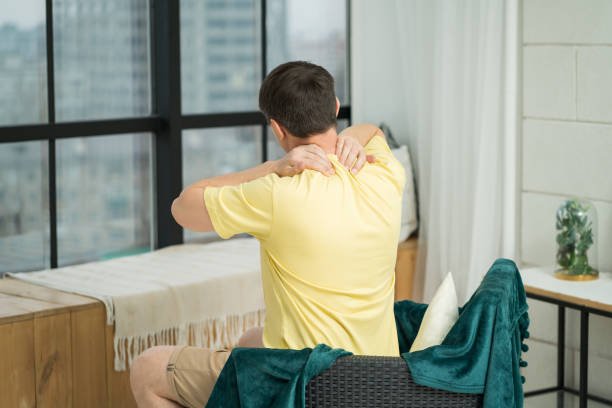Table of Contents
What Organ Can Cause Upper Back Pain?
Introduction
The upper back, also called the thoracic spine, is a complex area with muscles, ligaments, and vertebrae. We often associate upper back pain with muscle strain or injury. However, sometimes, the discomfort originates from underlying organ issues. Let’s delve into the organs that can cause upper back pain and explore when to seek medical attention.
Organs Behind The Upper Back Pain
Several organs located near the upper back can cause referred pain, meaning the discomfort is felt in a different area than the source. Here are the main culprits:
-
Gallbladder:
Located in the upper right abdomen, the gallbladder stores bile used for digestion. Gallstones, hardened deposits of cholesterol and bilirubin, can cause pain that radiates to the upper right back, between the shoulder blades.

-
Kidneys:
Situated low in the back on either side of the spine, the kidneys filter waste from the blood. Inflammation or infection (pyelonephritis) in the kidneys can cause a dull ache or sharp pain in the upper back, flank (side), or lower abdomen.
-
Pancreas:
Located behind the stomach, the pancreas produces digestive enzymes and hormones. Pancreatitis, an inflammation of the pancreas, can cause severe upper back pain that may worsen after eating.
-
Aorta:
The main artery carrying blood away from the heart is located near the upper back. Aortic dissection, a tear in the inner layer of the aorta, can cause sudden and severe upper back pain that radiates to the chest or neck.
Additional Causes Of Upper Back Pain
While organs can be the source, other factors can also contribute to upper back pain:
-
Muscle Strain Or Overuse:
Poor posture, repetitive movements, or heavy lifting can strain muscles in the upper back.
-
Spinal Issues:
A herniated or bulging disc in the upper back can press on nerves and cause pain, numbness, or weakness.
-
Osteoarthritis:
Degenerative changes in the joints of the spine can lead to stiffness and pain.
When To See A Doctor For Upper Back Pain
Though upper back pain can be caused by various factors, some signs indicate a need for medical attention:
-
Severe Or Persistent Pain:
Pain that doesn’t improve with home care or worsens over time warrants a doctor’s visit.
-
Radiating Pain:
Pain that travels down your arm, leg, or chest could signal a pinched nerve or other complications.
-
Numbness Or Tingling:
Numbness or tingling in your arm, leg, or around your upper back can be a cause for concern.
-
Fever:
A fever along with upper back pain could indicate an infection in an organ like the kidneys.
-
Difficulty Breathing:
Trouble breathing, especially with upper back pain, can be a sign of a serious condition and requires immediate medical attention.
-
Sudden And Intense Pain After An Injury:
If you experience sudden and severe upper back pain following an accident or fall, seek medical attention promptly.
Additional Tips
If you’re experiencing upper back pain, here are some tips for relief:
-
Apply Heat Or Ice:
Use a heating pad or ice pack for 15-20 minutes at a time, several times a day, to reduce pain and inflammation.
-
Maintain Good Posture:
Stand tall with your shoulders back and relaxed, and keep your ears in line with your shoulders.
-
Practice Relaxation Techniques:
Deep breathing exercises and yoga can help ease muscle tension.
-
Over-the-counter Pain Medication:
Pain relievers like ibuprofen or acetaminophen can offer temporary relief.
Remember: These tips are for general information only and should not replace seeking professional medical advice.
Frequently Asked Questions (FAQs) About Upper Back Pain
-
Can Stress Cause Upper Back Pain?
Yes, stress can contribute to muscle tension and upper back pain. Relaxation techniques can be helpful.
-
What Kind Of Exercise Is Good For Upper Back Pain?
Gentle stretches and strengthening exercises for the upper back muscles can improve flexibility and reduce pain. Consult a healthcare professional for a personalized exercise plan.
-
Should I See A Doctor If My Upper Back Pain Is On The Left Side?
While some organs like the gallbladder are on the right, pain can radiate to either side. It’s best to see a doctor to determine the cause, regardless of the pain location.
-
How Long Does Upper Back Pain From A Pulled Muscle Typically Last?
Muscle strain pain usually improves within a few days to weeks with rest and home care.
Conclusion
Upper back pain can be a puzzling issue. While muscle strain or injury is a common culprit, sometimes the discomfort stems from underlying organ problems. The key is to be aware of the potential causes and seek medical attention if you experience any concerning symptoms. Early diagnosis and treatment can lead to faster relief and prevent complications.
Remember: Don’t hesitate to consult your doctor if your upper back pain is severe, persistent, or accompanied by concerning symptoms like radiating pain, numbness, fever, or difficulty breathing. A healthcare professional can conduct a thorough examination and recommend the appropriate treatment plan to get you back on track to feeling your best.
References:
- Mayo Clinic. (2022, March 02). Upper back pain. https://my.clevelandclinic.org/health/symptoms/22866-upper-back-pain
- National Institute of Diabetes and Digestive and Kidney Diseases. (2021, December 09). Gallstones. https://www.niddk.nih.gov/health-information/digestive-diseases/gallstones
- National Institute of Diabetes and Digestive and Kidney Diseases. (2022, April 28). Pancreatitis. https://www.niddk.nih.gov/health-information/digestive-diseases/pancreatitis
Discover more from Pain Relief Methods
Subscribe to get the latest posts sent to your email.


This is so helpful! I’ve been searching for this info everywhere.